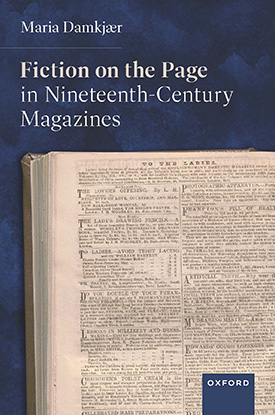Fiction on the Page in Nineteenth Century Magazines
Doctoral defence by Maria Damkjær.
Read the dissertation (PDF)
What makes fiction recognisable as fiction? Texts are shaped by their material print, but this book argues that they can also be made in response to it: that the needs of the magazine in the nineteenth century spurred writers to create hybrid, entangled texts. Using book history, genre theory, and literary close-reading, this book argues that narrative fiction in the nineteenth-century popular periodical was a malleable substance. By looking at typography, and the attempts to squeeze in too much text, or stretch out too little text, the book asks what the relationship was between the page that needed filling and the short story that tried to fill it. In the messy hybrids and outliers, we explore what fiction might have become.
The book works with magazines like the Englishwoman’s Domestic Magazine (first series, 1852-59), the Family Herald (1842 1945), the Home Circle (1849-54), and authors like Elizabeth Gaskell, George Augustus Sala, and Samuel Beeton. It also includes a chapter on Charles Dickens’s arguably least successful venture, Master Humphrey’s Clock (1840-1), where Dickens was noticeably straining to sell and fill a weekly magazine. While the book is not attempting to destabilise the status of canonical fiction, it does ask how the page makes fiction happen; what kind of readers magazines imagined for themselves; and what readers thought they were reading when they picked up an issue. The book argues that magazines projected a print imaginary, a symbolic realm where the magazine fits perfectly into the lives of happy, active readers.
Hvad er det der gør fiktion genkendeligt som fiktion? Alle trykte tekster formes af deres fysiske inkarnation, men denne bog argumenterer for at tekster også kan opstå som svar på den fysiske form; at tidsskrifternes behov for fyld og reklame i 1800-tallet ansporede forfattere til at skrive hybridtekster, der var dybt filtret sammen med det trykte produkt. Ved at kombinere boghistorie, genreteori og litterær analyse, argumenterer denne bog for at narrativ fiktion i 1800-tallets tidsskrifter var et plastisk svar på et indholdsbehov. Bogen undersøger typografi, klemte tekster og udstrakte layouts, og afdækker hvad forholdet var mellem den side der skulle fyldes og den novelle der blev brugt til at fylde den. I rodede hybrider og perifere genrer kan vi se hvad fiktion kunne være udviklet sig til.
Bogen analyserer populære tidsskrifter som Englishwoman’s Domestic Magazine (første serie, 1852-59), Family Herald (1842-1945), Home Circle (1849-54), og forfattere som Elizabeth Gaskell, George Augustus Sala, og Samuel Beeton. Den indeholder også et kapitel om Charles Dickens’ nok største kreative fiasko, ugebladet Master Humphrey’s Clock (1840-1). Bogen er ikke et forsøg på at destabilisere litteraturkanonen, men den spørger helt grundlæggende: hvordan genererer den trykte side en bestemt slags fiktion der ’passer’ til den ledige plads; hvad slags læsere forestillede tidsskriftet sig at det havde; og hvad troede læserne at det var de læste når de sad med et nummer i hænderne?
 Official opponents
Official opponents
Professor Meredith McGill, Rutgers (University of New Jersey)
Professor Paul Goring (University of Trondheim)
Chair of Defence
Dean, Professor Kirsten Busch Nielsen (University of Copenhagen)
The defence is open to the public and will be conducted in English.
Ex-auditorium opponents must sign up with the Chair of Defence.
Map of South Campus
View directions.
View on map of the Faculty of Humanities - South Campus.
View map of South Campus (pdf).
